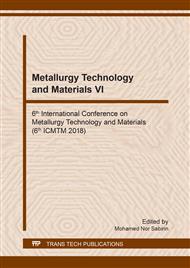[1]
X. Ma, X. Y. Ni, Using upconversion nanoparticles to improve photovoltaic properties of poly(3-hexylthiophene)-TiO2 heterojunction solar cell, J. Nanopart. Res. 15 (2013) 1547-1553.
DOI: 10.1007/s11051-013-1547-z
Google Scholar
[2]
J.G. Song, L. Hua, Q. Shen, Effect of pH value on the properties of SnO2 nano-cystalline for dye sensitized solar cells, Key Eng. Mater. 633 (2015) 273-276.
DOI: 10.4028/www.scientific.net/kem.633.273
Google Scholar
[3]
W.Y. Shi, B.S. Peng, Y.Y. Guo, Synthesis of asymmetric zinc phthalocyanine with bulky diphenylthiophenol substituents and its photovoltaic performance for dye-sensitized solar cells, J. Photochem. Photobiol. A: Chem. 321 (2016) 248-256.
DOI: 10.1016/j.jphotochem.2016.02.009
Google Scholar
[4]
L.J. Li, C.L. Wang, J.Y. Liao, Arumugam manthiram dual-template synthesis of N-doped macro/mesoporous carbon with an open-pore structure as a metal-free catalyst for dye-sensitized solar cells, J. Power Sourc. 300 (2015) 254-260.
DOI: 10.1016/j.jpowsour.2015.09.076
Google Scholar
[5]
R. Li, Y. Zhao, R.E. Hou, Enhancement of power conversion efficiency of dye sensitized solar cells by modifying mesoporous TiO2 photoanode with Al-doped TiO2 layer, J. Photochem. Photobiol. A: Chem. 319 (2016) 62-69.
DOI: 10.1016/j.jphotochem.2016.01.002
Google Scholar
[6]
J. Du, F. Bittner, D.S. Hecht, A carbon nanotube-based transparent conductive substrate for flexible ZnO dye-sensitized solar cells, Thin Solid Film. 531 (2013) 391-397.
DOI: 10.1016/j.tsf.2012.12.051
Google Scholar
[7]
S.A. Mozaffari, M. Ranjbar, E. Kouhestanian, An investigation on the effect of electrodeposited nanostructured ZnO on the electron transfer process efficiency of TiO2 based DSSC, Mater. Sci. Semicond. Process. 40 (2015) 285-292.
DOI: 10.1016/j.mssp.2015.06.081
Google Scholar
[8]
J.T Park, C.S Lee, J.H. Kim, High performance electrocatalyst consisting of CoS nanoparticles on an organized mesoporous SnO2 film: its use as a counter electrode for Pt-free, dye-sensitized solar cells, Nanoscale. 7 (2015) 670-678.
DOI: 10.1039/c4nr05779a
Google Scholar
[9]
A. Abdelkrim, S. Rahmane, O. Abdelouahab, Effect of solution concentration on the structural, optical and electrical properties of SnO2 thin films prepared by spray pyrolysis, Int. J. Light Elect. Optic. 127 (2016) 2653-2658.
DOI: 10.1016/j.ijleo.2015.11.232
Google Scholar


